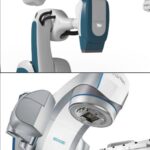
The cancer experts at CyberKnife Miami are often asked what is the difference between CyberKnife and Varian Edge Technology? While many cancer patients are told by cancer centers that they are the same thing, that’s not exactly correct.
Indeed, both are a form of radiation therapy that target and deliver high doses of radiation to tumors in the body, and both are known as Stereotactic Radiosurgery (SRS) and/or Stereotactic Body Radiotherapy (SBRT).
Despite its name, Radiosurgery is a radiation treatment, not a surgical procedure.
Although both machines achieve the same thing, destroying tumors anywhere in the body, there are some very significant differences between Varian Edge and CyberKnife.
CyberKnife is mounted on a robotic arm which is much more flexible. Like a human arm it has a greater freedom of movement. It delivers radiation beams from 1200 different angles, unlike Varian Edge, which is a conventional linear accelerator and has rotational movement from only one plane.
This CyberKnife flexibility ensures that treatment can safely avoid critical, healthy tissue and nearby vital organs from being damaged by very high doses of radiation delivered to the tumor site.
Varian Edge is gantry-based equipment. It’s not as flexible. It turns on an axis of 360 degrees.
CyberKnife also uses what’s called a Synchrony Respiratory Tracking System which tracks the continuous motion of the tumor and adjusts each beam with the motion of the lesion.
This missile guidance technology allows the system to accurately track the tumor, targeting it with pinpoint accuracy during the entire treatment.
So, when the patient breathes, CyberKnife’s missile guided technology sees this movement and adjusts the beam to the tumor’s new position, remaining only on the tumor site. Thus, it can treat a much smaller area.
There is no need to treat a large area surrounding the tumor site and potentially cause damage to surrounding healthy tissue or nearby vital organs.
Varian Edge sometimes uses Respiratory Gating which follows the motion of the tumor and turns the beam on and off as the lesion moves in and out of the treatment field. The patient is placed in position and told to lay as still as possible.
There is a devise placed to restrict respiration. During treatment, the machine halts the treatment until the tumor returns to the treatment area.
Due to uncertainty there needs to be a larger area included in which surrounding tissue and organs might be damaged.
So due to this uncertainty the radiation oncologist must plan to treat a bigger area so they can ensure the tumor is treated effectively.
The CyberKnife was invented at Stanford Health Care and first debuted in 1994. It received full FDA approval in 2001 to treat tumors anywhere in the body and has been used to successfully treat hundreds of thousands of patients worldwide.
If you would like to consult with a CyberKnife expert contact us at 305-279-2900.
We are among the most experienced CyberKnife team anywhere in the world.
This information is provided by Gail L. Suarez, MSHSA, RT (R)(T) and VP Operations CyberKnife Center of Miami
